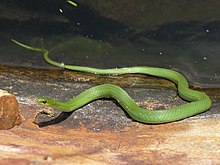Smooth green snake
| Smooth green snake | |
|---|---|

| |
| A smooth green snake in Ontario | |
| Scientific classification | |
| Kingdom: | |
| Phylum: | |
| Subphylum: | |
| Class: | |
| Order: | |
| Suborder: | |
| Family: | |
| Subfamily: | |
| Genus: | |
| Species: | O. vernalis
|
| Binomial name | |
| Opheodrys vernalis (Harlan, 1827)
| |
| Synonyms | |
The smooth green snake (Opheodrys vernalis) is a non-venomous North American colubrid. It is also referred to as grass snake.
Description
The smooth green snake is slender.[2] Its size classified as a "small medium" snake, reaching to 36–51 cm as an adult. The largest smooth green snake was measured as being 66 cm (26 in) long.[3] It is uniform light green on its back, with a yellow or white belly, and has smooth dorsal scales,[4] unlike those of the rough green snake. When a smooth green snake is first born, its scales are a different color than when it ages.[2] It can be olive green, blue-gray, or even brown when it is first born, and turn its characteristic green after its skin sheds for the first time. Typical for a non-venomous snake, its eyes are large and round. It uses its tongue, red with a black end, by flicking it in and out of its mouth to "smell" what is around it.[5]
Subspecies
- Eastern smooth green snake, Opheodrys vernalis vernalis (Harlan, 1827)
- Western smooth green snake, Opheodrys vernalis blanchardi Grobman, 1941
- Northern smooth green snake, Opheodrys vernalis borealis Grobman, 1992[6]
Geographic range
The smooth green snake had been found in areas across the northern half of the United States, as well as southern Canada. In the U.S., its range stretches from New England to Montana.[5]
Conservation status
It is a snake of increasing conservation concern in some U.S. states.
Habitat
The snake can be found in many different habitats, including marshes, meadows, the edges of streams, and open woods. The prefer to be on the ground, in opens areas without a lot of shrubs. During hibernation, the smooth green snake looks for burrows, ant hills, and other dug-out underground areas. Also, the normally hibernate in large numbers.[2]
Behavior
Diet
Smooth green snakes mostly eat insects and spiders. However, they will also eat millipedes, centipedes, salamanders, and slugs.[2]
Reproduction
The females lay small cylindrical eggs. There are usually 3 to 13 eggs in a clutch, and may hatch in as little as 4 days.
References
- ^ Template:IUCN2008
- ^ a b c d "Smooth green snake". Townson University. Retrieved 24 October 2011.
- ^ Conant 1975
- ^ Schmidt 1941
- ^ a b "Northern Rockies Natural History Guide". The University of Montana. Retrieved 21 November 2011.
- ^ Grobman, Arnold B. (1999). "Metamerism in the Snake Opheodrys vernalis, with a Description of a New Subspecies". Journal of Herpetology. 26 (2): 175–186.
{{cite journal}}: Invalid|ref=harv(help)
Bibliography
- Conant, Roger (1975). A Field Guide to Reptiles and Amphibians of Eastern and Central North America (2nd ed.). Boston: Houghton Mifflin.
{{cite book}}: Cite has empty unknown parameters:|Last2=and|First2=(help); Invalid|ref=harv(help) - Schmidt, K.P.; Davis, D.D. (1941). Field Book of Snakes of the United States and Canada. New York: G.P. Putnam's Sons.
{{cite book}}: Invalid|ref=harv(help) - Wright, A.H.; Wright, D.D. (1957). Handbook of Snakes of the United States and Canada. Ithaca and London: Comstock.
{{cite book}}: Invalid|ref=harv(help)

